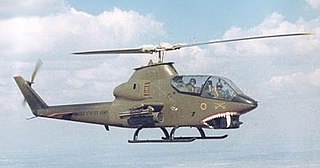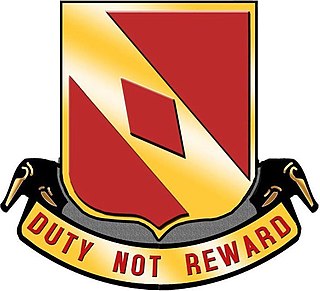
The Bell AH-1 Cobra is a single-engined attack helicopter developed and manufactured by the American rotorcraft manufacturer Bell Helicopter. A member of the prolific Huey family, the AH-1 is also referred to as the HueyCobra or Snake.

The 101st Airborne Division (Air Assault) ("Screaming Eagles") is an air assault infantry division of the United States Army that specializes in air assault operations. It can plan, coordinate, and execute multiple battalion-size air assault operations to seize terrain. These operations can be conducted by mobile teams covering large distances, fighting behind enemy lines, and working in austere environments with limited or degraded infrastructure. It was active in, for example, foreign internal defense and counterterrorism operations in Iraq, in Afghanistan in 2015–2016, and in Syria, as part of Operation Inherent Resolve in 2018–2021.

The 1st Cavalry Division is a combined arms division and is one of the most decorated combat divisions of the United States Army. It is based at Fort Cavazos, Texas. It was formed in 1921 and served during World War II, the Korean War, the Vietnam War, the Persian Gulf War, with the Stabilization Force in Bosnia-Herzegovina, in the Iraq War, in the War in Afghanistan as well as Operation Freedom's Sentinel and Operation Inherent Resolve. As of July 2023, the 1st Cavalry Division is subordinate to III Armored Corps and is commanded by Major General Kevin D. Admiral.

Air assault is the movement of ground-based military forces by vertical take-off and landing (VTOL) aircraft, such as helicopters, to seize and hold key terrain that has not been fully secured, and to directly engage enemy forces behind enemy lines. In addition to regular infantry training, air-assault units usually receive training in rappelling, fast-roping techniques, and air transportation. Their equipment is sometimes designed or field-modified to allow better transportation and/or carrying within aircraft.
The Rapid Deployment Joint Task Force (RDJTF) is an inactive United States Department of Defense Joint Task Force. It was first envisioned as a three-division force in 1979 as the Rapid Deployment Force (RDF), a highly mobile rapid deployment force that could be rapidly moved to locations outside the normal overseas deployments in Europe and Korea. Its charter was expanded and greatly strengthened in 1980 as the RDJTF. It was inactivated in 1983, and re-organized as the United States Central Command (USCENTCOM).

Marine Light Attack Helicopter Squadron 367 (HMLA-367) is a United States Marine Corps helicopter squadron consisting of AH-1Z Viper attack helicopters and UH-1Y Venom utility helicopters. Originally commissioned during World War II, the squadron participated in combat operations on Peleliu and Okinawa. Reactivated during the Vietnam War, the squadron has served during numerous conflicts since. The squadron is based at Marine Corps Air Station Camp Pendleton, California and falls under the command of Marine Aircraft Group 39 (MAG-39) and the 3rd Marine Aircraft Wing.

The 1st Battalion, 227th Aviation Regiment is an attack helicopter battalion of the Combat Aviation Brigade, 1st Cavalry Division. The battalion is an AH-64 Apache battalion based at Fort Cavazos, Texas.

The 18th Aviation Brigade is an inactive aviation brigade of the United States Army. Its initial formation in 1987 drew upon the resources of the 269th Aviation Battalion, originally formed in 1966.
The 229th Aviation Regiment is an aviation unit of the United States Army.
Combat arms are troops within national armed forces who participate in direct tactical ground combat. In general, they are units that carry or employ weapons, such as infantry, cavalry, and artillery units. The use of multiple combat arms in mutually supporting ways is known as combined arms. In some armies, notably the British Army and Canadian Army, artillery and combat engineer units are categorized as combat support, while in others, such as the U.S. Army, they are considered part of the combat arms. Armored troops constitute a combat arm in name, although many have histories derived from cavalry units.

The 4th Battalion 227th Aviation Regiment is an attack reconnaissance battalion, also known as 4-227 ARB supporting the 1st Cavalry Division. They fly the AH-64D Apache Longbow and are based at Fort Cavazos, formerly Fort Hood, Texas.
Operation Texas Star was a military operation of the Vietnam War that took place in Quảng Trị and Thừa Thiên Provinces from 1 April to 5 September 1970.

The 17th Aviation Brigade was a military formation of the United States Army. It was originally activated at Nha Trang, Vietnam, as the 17th Aviation Group (Combat) on 15 December 1965 under the 1st Aviation Brigade. Later it moved to Tuy Hoa in November 1970 and then to Pleiku in January 1972. The group had the mission of commanding and controlling all non-divisional assets in II Corps Tactical Zone, under I Field Force. The 10th, 14th, 52d, 223rd and 268th Aviation Battalions as well as the 7th Squadron, 17th Cavalry served with the group.

The 20th Field Artillery Regiment is a field artillery regiment of the United States Army constituted 1 July 1916 in the Regular Army. It served in France during the First World War with the 5th Division, at St. Mihiel and Lorraine before inactivation on 5 September 1921 at Camp Bragg, North Carolina.

Camp Evans is a former U.S. Army and U.S. Marine Corps base northwest of Huế in central Vietnam.
The 1st Cavalry Division Artillery (DIVARTY) or "Red Team" is the Force Field Artillery Headquarters for the 1st Cavalry Division. The DIVARTY served with the division from 1941 to 2005, including combat service in World War II, the Korean War, the Vietnam War, Operations Desert Shield and Desert Storm, and Operation Iraqi Freedom and in peacetime in Japan, Korea, and Fort Hood, Texas. As the Force Fires Headquarters, the DIVARTY provides fire support coordination and mission command for the training and readiness of field artillery units across the division.

The 1st Battalion, 321st Field Artillery Regiment is an inactive field artillery battalion of the United States Army. The battalion served in World War I, World War II, Vietnam and the Global War on Terror with the 82nd Airborne and 101st Airborne Divisions, and with the 18th Field Artillery Brigade. The battalion was officially inactivated in March 2014, and its firing batteries were distributed throughout the 82nd Airborne Division.
Operation Randolph Glen was a joint U.S. Army and Army of the Republic of Vietnam (ARVN) military operation during the Vietnam War designed to keep pressure on the People's Army of Vietnam (PAVN) units in Thừa Thiên Province and prevent them from mounting any attacks on the populated coastal regions.
Firebase O'Reilly is a former Army of the Republic of Vietnam (ARVN) firebase located south of Quảng Trị in Quảng Trị Province, Vietnam.
The DMZ Campaign (1969–71) was a military campaign by the United States Army, United States Marine Corps (USMC) and the Army of the Republic of Vietnam (ARVN) against the People’s Army of Vietnam (PAVN) along the Vietnamese Demilitarized Zone (DMZ) in northern Quảng Trị Province from 1969 to 1971 during the Vietnam War.
















